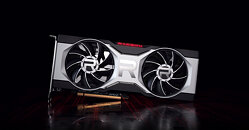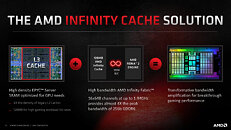Thursday, March 18th 2021

AMD Confirms it Won't Block any Workloads on its Graphics Cards - Including Mining
Hot on the heels of NVIDIA's recent Cryptocurrency Mining Processors (CMP) launch and slightly debacled driver-level neutering of popular mining algorithms with their latest GeForce RTX 3060, AMD product manager Nish Neelalojanan confirmed to PC Gamer that AMD's stance is a fundamentally different one: that they won't be the ones to decide what their customers can or can't do with their hardware. His words, precisely, were this: "We will not be blocking any workload, not just mining for that matter."
Nish then went on to speak on how AMD - and its current RDNA2 product stack - have been specifically geared and optimized for gaming workloads. There are some architectural choices present in RDNA2 that automatically reduce its utility and performance when it comes to mining, such as its infinity Cache - an architectural choice that aims to increase gaming performance by improving cache hits, at the expense of overall memory bandwidth (the most important metric for actual mining operations).This is why AMD's latest gaming behemoth RX 6900 XT, for example, offers about the same ~54 MH/s Ethereum mining performance as its older (and much smaller) RDNA-based RX 5700 XT. This is an interesting way to frame the problem, and it does naturally lead to lesser demand for AMD's graphics cards compared to NVIDIA's (the RTX 3090, for example, offers a gargantuan up to 120 MH/s in mining algorithms). This doesn't however mean that AMD isn't working on a CMP-like product line based on older technologies that can sate demand for cryptocurrency mining.
Nish then doubled-down on AMD's commitment to gaming:
"All our optimization, as always, is going to be gaming first, and we've optimized everything for gaming. Clearly, gamers are going to reap a ton of benefit from this, and it's not going to be ideal for mining workload. That all said, in this market, it's always a fun thing to watch." I beg to differ on that last part, though. It's definitely not fun to watch the state of the market for gaming-related hardware.
Source:
via TechSpot
Nish then went on to speak on how AMD - and its current RDNA2 product stack - have been specifically geared and optimized for gaming workloads. There are some architectural choices present in RDNA2 that automatically reduce its utility and performance when it comes to mining, such as its infinity Cache - an architectural choice that aims to increase gaming performance by improving cache hits, at the expense of overall memory bandwidth (the most important metric for actual mining operations).This is why AMD's latest gaming behemoth RX 6900 XT, for example, offers about the same ~54 MH/s Ethereum mining performance as its older (and much smaller) RDNA-based RX 5700 XT. This is an interesting way to frame the problem, and it does naturally lead to lesser demand for AMD's graphics cards compared to NVIDIA's (the RTX 3090, for example, offers a gargantuan up to 120 MH/s in mining algorithms). This doesn't however mean that AMD isn't working on a CMP-like product line based on older technologies that can sate demand for cryptocurrency mining.
Nish then doubled-down on AMD's commitment to gaming:
"All our optimization, as always, is going to be gaming first, and we've optimized everything for gaming. Clearly, gamers are going to reap a ton of benefit from this, and it's not going to be ideal for mining workload. That all said, in this market, it's always a fun thing to watch." I beg to differ on that last part, though. It's definitely not fun to watch the state of the market for gaming-related hardware.


73 Comments on AMD Confirms it Won't Block any Workloads on its Graphics Cards - Including Mining
And the kind of mindset that's greedy enough to screw up a whole market for a few bucks is often one and the same that will have zero hesitation about ripping off the buyer (eg, seller videoing himself holding up the card & serial no so it can be seen clearly on the video, then placing the card in its original box and packaging it up with the address of the sender & recipient clearly visible, then turning the video off, unpackaging it, swaps the GPU out for a $2 item (eg, book) with the same weight in the original GPU box, repackages it as it was seen in the video, then sends that tracked delivery then counter-claims to the buyer's non-receipt / incorrect item sent dispute "it was the buyer who swapped it out because he wanted to keep both the card and money, look I have video evidence of me packaging the card with the same serial no, sent it tracked, etc" (literally happened to someone I know the other day to which Ebay actually ruled in favour of the scammer because of the video). The second hand PC component market is mostly good for older / low value components that no-one bothers ripping off. When it comes to relatively new widely sought after high value GPU's, it's a fraudsters paradise that I wouldn't touch with a 10ft barge pole...
Igorslab is the place for the tools.
Also the BIOS is not a monolith and some parts of it can be customized (that's what AIB OEMs touch), and some are cryptographically protected and only AMD can release new versions.True, but even then a mining card which has been constantly loaded has potentially less component damage than a gaming card in which components are constantly electrically and thermally cycled. My experience with home lab GPU compute servers and my own gaming GPUs seem to confirm this, but this is only anecdotal evidence at best.This depends on the local consumer protection laws, and in the EU is not true.That's scummy behaviour that can be mitigated by always opening packages in the presence of the courier. With the shipping company statement on your side it's very hard to lose money to this type of scam. Again, consumer protection laws vary, but in many if not all EU countries warranty claims can be made from both the seller and original manufacturer.
So again, what enforces the signatures on these blobs? Nothing that can't be removed.
It's not open source no but crypto has the time and money to reverse engineer it.
I am a hobbyist bios modder, so pretty sure my perspective here is probably on target as I actually have the skills to begin attacking this, if anyone cared.
Sad times for PC gamers around the world.
Hold on to what you have, cleaning, good cooling and undervolt them :D
This is the same mechanism that Intel (and AMD) use for CPU microcode updates.
If you can remove this or rather break the crypto scheme used then you'd be a billionaire if not trillionaire :)
A truly reviewed and filtered queue system. Why something like this is not replicated everywhere speaks to true loyalties.I do not find this likely. We know this was true with Vega, and that they signed both ends of the firmware. If you stop signing one end, as we know they have (the one responsible for volts and clocks no less), it is indicative you have stopped all together.
1) only store the AMD public key and AMD would have to sign every single bios for every AIB card variant separately - that's a huge amount of useless work
2) contain a set of public keys for usage by OEMs - a waste of space, would have to contain every future OEM key at the time of chip's production
3) have some mechanism for one-time programming of the OEM key - difficult to do, risks bricking the chip on failed program, no real benefit so far since critical parts are already protected
This is speculation of course, but it mirrors how motherboard BIOSes are constructed with most using 3).The manufacturer would have to prove that what the consumer did with software actually managed to damage the hardware and cause the issue. I've yet to hear of any manufacturer claiming this with computer hardware. This is purely economics - it'd take more time and thus money to prove the consumer wrong than to just replace/repair the part.Not necessary, the courier can take photos to attach to the report, for example. The shipping company then vouches to Ebay that the photo content was what was in the box. It's standard procedure.This is considered the fault of the receiving party. Tho not adhering to shipping company procedures, most couriers will allow you to call them in cases like those to "fix" a report even if he wasn't physically there. I know it's shady from the courier, but that's the reality of how they work. The safest route with hardware is to make sure you open the box with the courier present.I'm pretty sure that if a seller did this multiple times they'd get banned/investigated by Ebay. There's always a risk when buying hardware on auction services.
Foundry capacity is reserved up to several years in advance, sometimes before the factory is even built, and most often long before the various chip designers have decided what chips to use the capacity for.
The problem here is a combination of several factors, like not anticipating demand and lower wafer throughput than expected.I don't doubt there are cases of this happening, the interesting question is at what scale.
While mining is inherently pointless, the mining problem is very exaggerated. Graphics cards in general were in short supply going into this pandemic, then the pandemic created extreme demand, and then another mining bubble on top of that. The main reason why we are seeing a sever shortage now is the accumulated deficit over several months. Nvidia are making "regular" quantities of graphics cards, and a lot of customers are getting their cards, but the waiting lines are still seemingly growing due to the deficit.The GPU market is in millions of units, thousands going to miners and scalpers isn't that much of a problem.Well, obviously blocking "applications" is futile, just modifying a single byte of an application will get around checksums. Any "blocking" of mining workloads is one of two things; either it's just a BS claim done for PR, or it uses some kind of statistics to "guess" whether a workload is mining or not. The latter is a very dangerous alternative, and would result in many non-mining workloads getting reduced performance. Just imagine the lawsuits from customers who got their performance cut in half. This stuff is beyond stupid, and attempting to do this is probably the most stupid thing Nvidia has ever done. Those of you who can grasp the ramifications of this should be enraged.